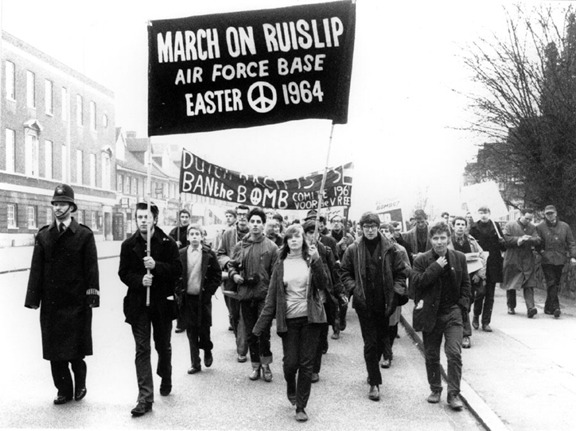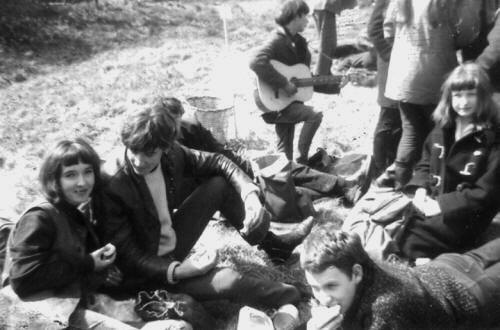|
|
| home | features | exhibitions | interviews | profiles | webprojects | archive |
|
Banning The Bomb Martin Val Baker In an abridged chapter from his memoirs, art and music promoter Martin Val Baker (pictured below looking at the camera, touching his collar), recalls the Aldermaston marches of the 1960s which were strongly supported by young people, including Martin and his friend, conceptual artist David Tremlett (see interviews).
This was the occasion of the massive Committee of 100 demonstration on September 17th, 1961, when over 1,200 were arrested as thousands of anti-nuclear protesters blocked Trafalgar Square in a peaceful sit-down. It was the largest mass arrest in British political history, the courts and cells throughout London were crammed full and barely able to cope with this sudden increase in population. When the police moved towards us I remembered the instruction to “go limp and weigh heavy”, as we were picked off one by one and carried to the Black Maria’s which were to ferry us to a local lock-up. On the way to gaol, locked in one of the van’s sixteen cells each fitted with barred windows, I caught sight of well- heeled patrons emerging from Covent Garden Opera House; quite a surreal contrast from my rather unusual viewpoint. Oddly, that remains my only ever glimpse of the national Opera House. At the police station as we shuffled in line to be charged, I got talking to a rather plump communist who gave his name to the police as Alan Sillittoe. It was indeed the celebrated writer of ‘Saturday Night & Sunday Morning’. Coincidentally my father shared a cell that night with John Osborne and George Melly, whilst Jess was in gaol with Vanessa Redgrave and Shelagh Delaney - quite a literary week end! The fourth member of the Val Baker family on the coach up, Gill, had also been arrested, along with our friends Llewellyn Baker and David Tremlett (picture below: in leather jacket holding sandwich (Aldermaston 1965)), but all three were released as they were under seventeen. To be deprived of one’s liberty is an enormous shock to the system when first it happens. Suddenly there are doors you cannot go through and strange faces in uniforms telling you what you can and cannot do. Thirteen of us were put into one cell, doing our best to while away an uncomfortable night, lying on the floor with the lights on all the time. In the morning we were each fined the princely sum of twenty shillings and turned out into the street again. Just as losing liberty was a enormous shock, regaining freedom that day was one of the most tremendous experiences of my life, opening doors...fresh air..., obviously a fairly trivial matter compared with the experience of many others in other countries, but pretty significant on a personal level.
Back in West Cornwall Jonathan Baker, Hugh Fido and I (all Penzance Grammar School boys who had been arrested) were interviewed by the local paper- which led to calls for our expulsion, a call that the headmaster kindly ignored. At my suggestion my father wrote a letter in to the school explaining my days’ absence saying that I had been ‘unavoidably detained.’ There were many other similar demonstrations at that time. The four-day C.N.D. Easter march from the Aldermaston Atomic research station to Trafalgar Square, which had been staged annually since 1958, was probably at its peak when I joined it during the years from 1961 to 1964, with up to 200,000 people marching in to London at the end. The Cornwall and Devon contingent, including a group from Heligan with a banner proclaiming it ‘100% unilateral’ (picture below 1963), was notable for taking its own catering section - rather like an army on the march. There was an incredible cross-section of the sixties left; pacifists, socialists, anarchists, communists, youth groups, pensioners, mums with babies, deadly serious people, light hearted people, jazz bands, folk singers, the famous and the infamous....Because of the vast numbers involved we moved forward in a sort of slow shuffle which was immensely tiring. At the end of the day we collapsed exhausted to see to our blisters, sleeping in our hundreds on floors of the school buildings which had been secured by C.N.D. to accommodate us. In those days the main argument within the Peace movement was between the Committee of 100, led by Bertrand Russell, which believed in Gandhian non-violent civil disobedience, and the Campaign for Nuclear Disarmament (Chairman Canon Collins) which believed in a more moderate approach to the cause, with marches and vigils. In Easter 1963 members of the Committee somehow managed to find out the location of the Government’s secret 'Regional Seats of Government'. These were isolated bunkers where Harold Macmillan’s men would have fled to in the event of a nuclear war to run what was left of the country. This was all part of the Civil Defence system which was thought to encourage acceptance of nuclear war as a survivable option, so we were of course against it. Fortuitously one of these R.S.G.’s was just off the route of the 1963 Aldermaston march so around 3000 supporters of the Committee suddenly peeled off the road and after a couple of miles down country lanes and through some woods, hotly pursued by the press -who had been primed, we came across a rather sinister looking underground shelter surrounded by a massive gathering of police - who presumably had also been primed.
There was another sit-down followed by
arrests, this time at Parliament Square and then I was involved in a
demonstration in 1964 at the U.S. Airforce base at Greenham Common when
we blockaded the base for twenty four hours. This was of course years
before the famous women’s peace camps and both sexes sat down and were
carried away to be processed together at a nearby makeshift magistrates
court. As soon as we were released we returned to the demonstration and
sat down again. Throughout the night we were being heckled by a group of
Empire Loyalists (the name by which the right-wingers went by in those
days) when a friend from Cornwall, the Canadian sculptor Bill
Featherstone, had the bright idea of provoking them into physically
attacking him, upon which the rightists were immediately arrested and at
last we had a peaceful night. Although C.N.D. revived successfully in the 1980’s -by then I was involved in other things.
The complete memoir is available here: http://www.rainydaygallery.co.uk/musicarchive.html see 'interviews' for David Tremlett on Beatniks, the Royal College and British Conceptual art |
|
|

 My
father (Denys Val Baker) and Jess (his wife) had been arrested at a sit
down in Trafalgar Square early in 1961 and later that year my sister
Gill and I joined them on what turned out to be quite a memorable return
trip to the big city. Forty-one of us boarded the coach at Camborne late
that autumn evening, but when it returned from London the following day
there were only eleven people on it - the rest of us had been gaoled.
My
father (Denys Val Baker) and Jess (his wife) had been arrested at a sit
down in Trafalgar Square early in 1961 and later that year my sister
Gill and I joined them on what turned out to be quite a memorable return
trip to the big city. Forty-one of us boarded the coach at Camborne late
that autumn evening, but when it returned from London the following day
there were only eleven people on it - the rest of us had been gaoled.

 It
was a brilliant publicity coup for the Committee. We blockaded the place
for an hour or so and then rushed off to try and catch up with the main
body of the march. Photographs, stories and film were all over the press
that evening and the following day. The activists who had published the
original R.S.G. locations were prosecuted under the Official Secrets
Act, bringing further publicity to the cause.
It
was a brilliant publicity coup for the Committee. We blockaded the place
for an hour or so and then rushed off to try and catch up with the main
body of the march. Photographs, stories and film were all over the press
that evening and the following day. The activists who had published the
original R.S.G. locations were prosecuted under the Official Secrets
Act, bringing further publicity to the cause.